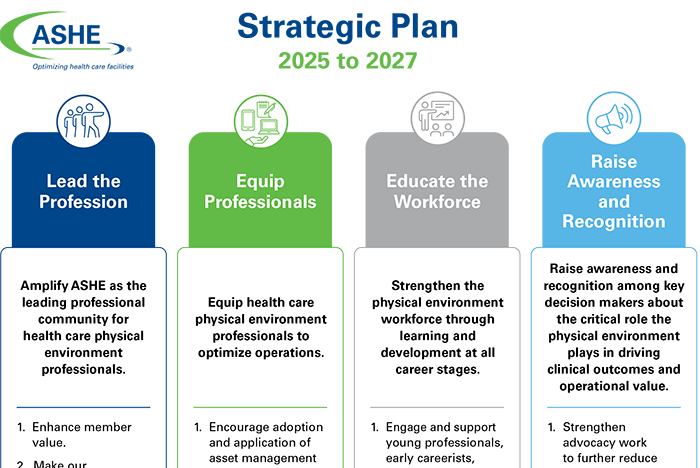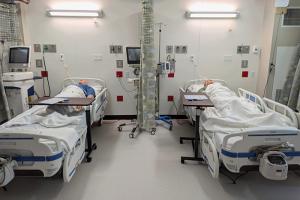ASHE lays out its three-year strategy

Image from Getty Images
The mission of the American Society for Health Care Engineering (ASHE) is short and simple: Dedicated to optimizing the health care physical environment. But those succinct eight words are the driver behind a thorough and synchronized strategic plan that will help guide every decision ASHE makes over the next two years.
Earlier this year, ASHE staff and the ASHE Advisory Board came together to develop the association’s 2025-2027 strategic plan. Each member brought their wealth of knowledge and professional expertise that comes from decades of career experience. The team also leveraged data-driven resources, such as past ASHE Member Surveys and surveys conducted by Health Facilities Management, including the annual Hospital Construction Survey and biennial Salary Survey. They also engaged focus groups with ASHE chapter leaders to ensure the plan not only befits a national framework but also can be applied at a local level.
The plan is built of four pillars, with three focused objectives within each pillar that layout the “how” for achieving them.
- Lead the Profession. Amplify ASHE as the leading professional community for health care physical environment professionals.
- Equip Professionals. Equip health care physical environment professionals to optimize operations.
- Educate the Workforce. Strengthen the physical environment workforce through learning and development at all career stages.
- Raise Awareness and Recognition. Raise awareness and recognition among key decision makers about the critical role the physical environment plays in driving clinical outcomes and operational value.
Lizzie Ortolano, executive director of ASHE, explains that the four pillars directly address the challenges members face.
“Health care facilities are navigating a lot of complexities. From aging infrastructure and workforce shortages to the growing need for resilient, sustainable and technology-integrated environments,” Ortolano says. “We continue to see more regulatory demands, cyber threats to systems and long-term effects of deferred maintenance and in some cases, weather events that impact operations.”
The plan also speaks to the goals ASHE members hope to achieve.
“Bottom line is, ‘The patient comes first,’” Ortolano explains. “I can’t recall the number of times this phrase comes out of the mouths of our members. We want to make sure we’re elevating the great importance of health care facilities management and the role it plays in creating a safer and more resilient healing environment.”
Equal and united
As with any well-designed structure, each pillar within the strategic plan can stand on its own but they are strengthened when established together. Ortolano says the pillars are purposefully not numbered, denoting their equal importance in the larger plan and the synchronization between each one.
For instance, ASHE’s work to educate the physical environment workforce at all career stages will ensure that professionals are equipped to optimize operations. And raising awareness and recognition about the critical role the physical environment plays in health care supports the goal of leading the profession and enhancing member value.
ASHE’s Health Care Facilities Management Essentials Series is a multiyear project that both equips and educates the workforce. It establishes the association and its members who engage in the series as authorities on the essential skills needed to succeed in this field. The series is composed of nine handbooks (five have been released with one more coming in 2025 and the final three in 2026) and corresponding educational programs.
The series also aligns with the ASHE Core Competency Framework, which charts out the eight key skills of health care facilities management: compliance, sustainability, finance, energy management, maintenance and operations, project management, assessing risk and administration. The framework takes ASHE’s multitude of resources and tags them based on these groupings, making them easily accessible to members who want to fill knowledge gaps or further their expertise in certain areas.
ASHE also offers Quick Training online courses, which are focused, free and fast for on-the-go learners.
“Accessible education is a top priority when we’re looking into the future,” Ortolano says. “With multiple generations and access to knowledge at our fingertips, learners have different expectations than in the past. Accessibility can mean multiple things, and it does mean multiple things to our members: cost modality, variety and level. Our continued expansion of our virtual learning platform is really exciting. We’ve organized our library based on discipline (e.g., facility management or design and construction) as well as modality (e.g., instructor-led, webinar or on-demand.)”
History lessons
The pillars also build upon the work of previous strategic plans and work done at ASHE.
In the 2022-2024 strategic plan, one of the goals focused on how to define operational optimization. The work done to achieve that goal is evident in products and initiatives like the Core Competency Framework, but there is more progress to be made surrounding “how” to achieve optimization.
In this new plan, “We have a large emphasis on reliability-centered maintenance,” Ortolano says. “This was a huge component that came out of our previous plan. Now we need to pull our community of experts together to identify ways for others to learn, build case studies and education.”
ASHE is also using the current plan to build upon past efforts to propel workforce development.
In 2023, ASHE acquired the Mechanic Evaluation and Certification for Health Care (MECH) program. Today, it’s leveraging the MECH and the ASHE Health Care Physical Environment Worker Certification as part of the foundation for a training program called the Healthcare Facility Technician Course. The program was piloted in collaboration with Northshore Technical Community College and North Oaks Health Systems, both based in rural Hammond, La., and the first cohort graduated earlier this year. Ortolano says the vision is to work alongside ASHE Chapters, using their on-the-ground knowledge to help build local pipelines of educated and prepared physical environment professionals.
Forward together
Ultimately, these initiatives help to establish ASHE and its members as the go-to authorities when it comes to advocacy and ensuring the voice of physical environment professionals is amplified across all areas of health care. Recent advocacy efforts include an alert explaining major standards changes at The Joint Commission released last week. ASHE's Regulatory Affairs Team quickly notified its members of the changes, what they mean for Joint Commission-accredited facilities and updated its Physical Environment Survey Readiness Program to reflect the updates.
As part of the American Hospital Association (AHA), Ortolano says it is intentional in collaborating with the larger organization and other AHA Professional Membership Groups with expertise in environmental services, supply chain, risk management, strategic planning and capacity management to expand the field’s influence. To that same end, ASHE Advisory Board members are attending and speaking at conferences geared toward health care executives to share the breadth of ASHE’s knowledge, earning more recognition and opening new opportunities for the field.
Visit ASHE’s website to learn more about its 2025-2027 strategic plan.





